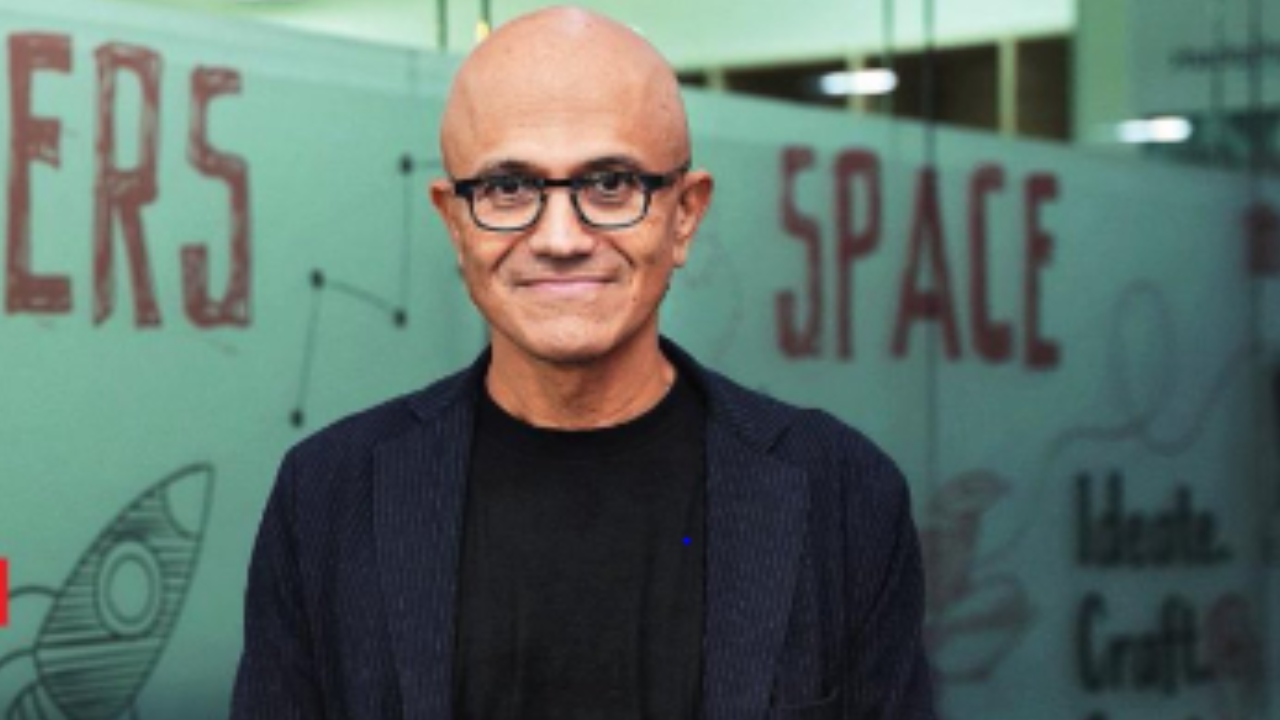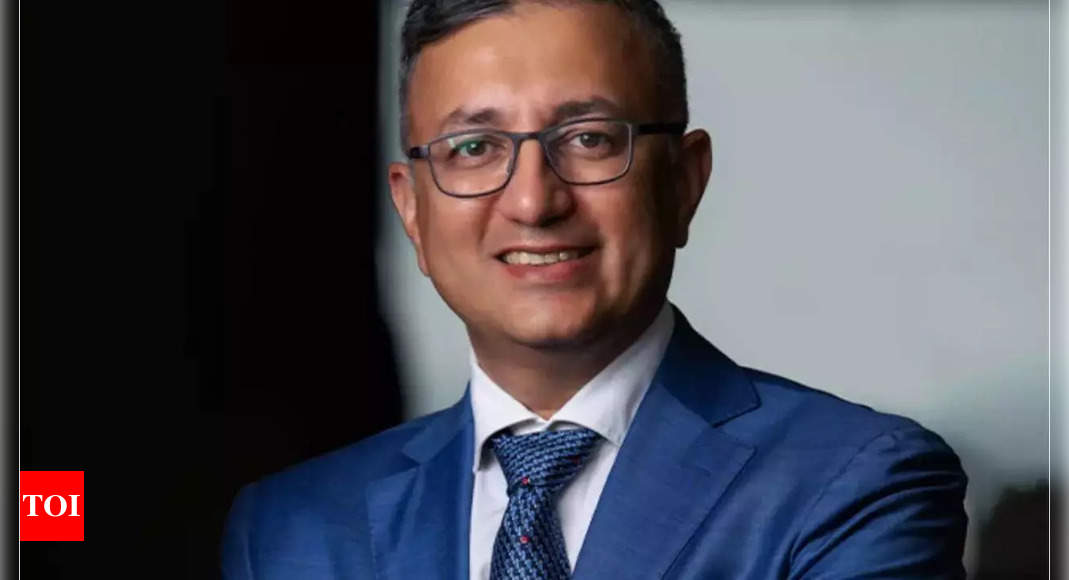India leading the world with solutions like digital public goods and Bhashini: Satya Nadella India News
Microsoft Chairman and ceo Satya Nadella says the IT Ministry’s sponsorship of multilingual speech-to-text and text-to-speech stack is very impressive; It is predicted that it will be able to create incredible innovations such as allowing students to call AI tutors on time
Born and brought up in Hyderabad, Satya Nadella was appointed the CEO of Microsoft on February 4, 2014, becoming only the third CEO of the iconic company. In the 10 years since then, Nadella has transformed Microsoft, which at the time was confused by what it missed on mobile. Became the world’s most valuable company with over $3 trillion. The company’s stock has risen more than 1,000% since he took charge. The transformation at Microsoft under Nadella’s leadership came first from his big push into cloud computing. Now, with their heavy investments in artificial intelligence (AI) infrastructure and solutions, they have pulled Microsoft’s valuation even ahead of Apple. Nadella was recently on a three-day visit to India, where he has 23,000 employees and a growing share of his business. On the final day, at Microsoft’s massive facility in Hyderabad, he took out time to have an exclusive chat with TOI.
Your ten years at the helm of Microsoft have been nothing short of amazing. Analysts are calling you the most influential technology executive since Steve Jobs. What do you think enabled you to accomplish this?
Every 10 years something big happens in our industry. I have been fortunate to be a part of four of these technology waves: PC client-server, Web/Internet, mobile cloud, and now AI. My mindset is this: This is the second year of AI, where we are scaling AI. I look back, and see, what the PC was like in the second year of client-server, what things we did, both right and wrong. What have we done when it comes to browsers and the Internet! What we did in mobile cloud! And this is the most important thing. And what will really matter is our ability to have a realistic perspective on the scope of technology, long before conventional wisdom. And then doing everything and creating something valuable. Although we are doing this, it is also important for it to happen at the grassroots level. After all, we are Microsoft. Microsoft exists because of its sense of purpose and mission. Here we are on the Microsoft campus, talking to our people about why we innovate, how we innovate, how we meet customers’ unmet, unexplored needs, constantly curating them. So, I go back to those pillars of a sense of purpose and mission and culture, and having a real understanding of where the arc of technology is, and not relying on what came before.
To get here you will also have to change the culture of the organization.
You have to be able to achieve things by working with the people around you, and especially in organizations like ours, where there is so much talent. And the question is can we all collectively become an organization learning all that, ultimately in service of one mission and one group of customers and partners – that has that hunger, that humility. One thing I always say is that there is a thin line between confidence and arrogance. You must be confident that you can learn from mistakes, but you cannot have the arrogance that you are somehow God’s gift.
You have one of the largest engineering and R&D centers in India. A lot of work around AI and even AI infrastructure happens here. How do you view India’s engineering capabilities and the larger Indian developer ecosystem?
One of the things I’m really keeping an eye on is where India is, and how Indian human capital, Indian businesses and Indian public sector organizations are adopting these new waves of technology. If I go back to the four platform changes, we had some moderate success with PC in India, web was big, mobile and cloud were really big. But I think AI can be even bigger. In the three days I spent here, I saw a few use cases. What is unique is that of India digital public goods (like Aadhaar, UPI) are now being combined with some of the innovations that Microsoft is bringing in in terms of the AI stack to allow this. speaker (AI-powered language translation system), Jugalbandi (multilingual chatbot) to create scenarios that are allowing students to call AI tutors on time. This is an incredible innovation that I didn’t even think of. The fact is, Indian software developers, Indian users, NGOs, all are coming together to imagine how to put these things together in unique ways. It’s the same with businesses. For Air India, Tata has an ambitious goal, let’s change the way Air India operates and deliver truly great service. He made one of the best customer-facing agents. A 100-year-old textile company like Arvind says, let’s bring efficiency into the way we do contracts and legal documents, but then make our commercial organization even better at actually doing these contracts. And you see that even in our development center, where we are sitting, we have incredible talent and they are all contributing. Someone at Microsoft asked me, what is an AI product; I said it all – there is not a single layer of the stack that has not been touched by AI. And there are people here who are making total contributions to what we’re doing. So, it’s an exciting time.
Should India create its own sovereign AI infrastructure? There are also those who say it is necessary to create solutions for India’s unique needs.
I think the approach of the government in India has always been quite enlightened. As I said, India is leading the world in some ways with these digital public goods. That’s why I was so impressed by the fact that the Ministry of Information Technology was behind Bhashini. They sponsored the speech-to-text and text-to-speech stack, so that it is truly democratized and always available multilingual for any application in India. And now you can, say, create a daisy chain with the latest models like GPT-4 Turbo and you can have a startup that can offer some very sophisticated AI capabilities in any Indian language. And that’s the magic – the success of sovereignty certainly comes from being able to exploit what I would call an available commodity and then add unique value to it, use it intensively and reduce the barriers to adoption. This is the path to development – development does not come by reinventing the wheel. Growth comes from making sure that you are not dependent on any one person or any one company, even Microsoft. Our goal as a platform company is to invest in India, whether it’s capital, whether it’s data centres, which are like modern factories. We are building compute utilities in India, so it is also sovereign, because it is on Indian soil.
Any suggestion to the government, anything they should think more about?
One thing I know the government cares about is how all this technology is ultimately benefiting Indian citizens, and how it is safe. Those are the two things that matter. Therefore, it is important to continue to have a rich dialogue with the private sector – participants like us – and then be able to come up with the right set of guidelines and norms. And, finally, also the rules. There are rules in food, in motor vehicles, in finance. There’s no reason why it should be any different in technology, especially technology applied in health care, applied in finance. So, the main suggestion would be to really make sure that you are getting the benefits, and the unintended consequences are what we are mitigating, rather than preventing overall progress.
You have been part of four tectonic shifts. Do you think the disruption in the labor market caused by AI is going to be profound?
I think that’s a great question. Let me start by basically saying, look, we shouldn’t fall into the labor illusion. He said, I am also clear that there will be displacement, but I will say a few things. One, in this change, you can say that it is easier to specialize to some extent to get better salary support. Let’s say you’re a frontline worker in manufacturing. You have domain expertise, but now you can easily learn some IT skills to build applications using only natural language signals. So suddenly, not only are you a very valuable member of the manufacturing staff, but you are now a member of the IT staff as well. And this will provide more employment opportunities and better salary support and increase productivity. I think it will happen in healthcare, it will happen in retail. In fact, one of the things I’m most looking forward to is our front-line jobs participating in our growing digital economy. Secondly, the level of learning and experience is coming down. I’m a college graduate, but then I want to learn real world skills faster, now we have the tools for that. We will be able to make more of our graduates more productive with better salaries in more industries. One of the best examples I saw this time in India is what Karya is doing – the fact that they are creating jobs for rural Indian women to participate in an emerging AI economy. This is not something we could have imagined two years ago. When I met this woman from rural Maharashtra, she was very excited about what she was doing. She was getting financial benefits and she was learning and she was also enjoying it. That feeling of empowerment was amazing to see.
If you had any advice for a young Indian, what would it be?
No matter who it is – young or mid-career professional – I think what’s important is the spirit of curiosity, the fearlessness of taking on new things. When I am with my co-pilot, I have that feeling of exploration, that feeling that I can learn anything, I can be well versed with things. I always say, God, I wish I had a co-pilot when I was studying electrical engineering and I couldn’t figure out Maxwell’s equations. That’s when I needed it. We are sometimes afraid to do new things because we think the learning process is difficult. We now have a tool that makes it easier to overcome the learning curve. And so, I think there’s no better time than now to be more fearless.
You mentioned how developers are in the golden age. But is AI going to pose some kind of existential risk to them, where it could replace humans in the loop?
As AI develops, we can all use AI to take the drudgery out of our work, improve our ability to learn things, and improve our ability to participate more fully in the world. I go back to what I saw here last time with Jugalbandi, where an Indian farmer was actually able to access services from the government with the help of AI. So, the human being is not being cut. If anything, human agency is being enhanced because the connection between, let’s say, a college degree and lots of knowledge, and human smarts is now breaking down. Therefore, I think humans can flourish. We have to think that if AI is spreading, how is it under control? One thing humans have done well is use powerful new technology to benefit us. I think we can do the same with AI, but it will require us to establish these norms and then translate those norms into laws and law enforcement and technological guardrails.
You have great interest in cricket. America is co-hosting the T20 World Cup. Are you going to watch India-Pakistan match in New York?
I hope so. If I get a ticket I will go. I’m a minority owner of one of the teams out of Seattle (Seattle Orcas). You won’t find a South Asian anywhere in the world who doesn’t love cricket and I love it as much as the next person.
How do you get Americans excited to watch cricket?
They will cheer themselves up (laughs).
Born and brought up in Hyderabad, Satya Nadella was appointed the CEO of Microsoft on February 4, 2014, becoming only the third CEO of the iconic company. In the 10 years since then, Nadella has transformed Microsoft, which at the time was confused by what it missed on mobile. Became the world’s most valuable company with over $3 trillion. The company’s stock has risen more than 1,000% since he took charge. The transformation at Microsoft under Nadella’s leadership came first from his big push into cloud computing. Now, with their heavy investments in artificial intelligence (AI) infrastructure and solutions, they have pulled Microsoft’s valuation even ahead of Apple. Nadella was recently on a three-day visit to India, where he has 23,000 employees and a growing share of his business. On the final day, at Microsoft’s massive facility in Hyderabad, he took out time to have an exclusive chat with TOI.
Your ten years at the helm of Microsoft have been nothing short of amazing. Analysts are calling you the most influential technology executive since Steve Jobs. What do you think enabled you to accomplish this?
Every 10 years something big happens in our industry. I have been fortunate to be a part of four of these technology waves: PC client-server, Web/Internet, mobile cloud, and now AI. My mindset is this: This is the second year of AI, where we are scaling AI. I look back, and see, what the PC was like in the second year of client-server, what things we did, both right and wrong. What have we done when it comes to browsers and the Internet! What we did in mobile cloud! And this is the most important thing. And what will really matter is our ability to have a realistic perspective on the scope of technology, long before conventional wisdom. And then doing everything and creating something valuable. Although we are doing this, it is also important for it to happen at the grassroots level. After all, we are Microsoft. Microsoft exists because of its sense of purpose and mission. Here we are on the Microsoft campus, talking to our people about why we innovate, how we innovate, how we meet customers’ unmet, unexplored needs, constantly curating them. So, I go back to those pillars of a sense of purpose and mission and culture, and having a real understanding of where the arc of technology is, and not relying on what came before.
To get here you will also have to change the culture of the organization.
You have to be able to achieve things by working with the people around you, and especially in organizations like ours, where there is so much talent. And the question is can we all collectively become an organization learning all that, ultimately in service of one mission and one group of customers and partners – that has that hunger, that humility. One thing I always say is that there is a thin line between confidence and arrogance. You must be confident that you can learn from mistakes, but you cannot have the arrogance that you are somehow God’s gift.
You have one of the largest engineering and R&D centers in India. A lot of work around AI and even AI infrastructure happens here. How do you view India’s engineering capabilities and the larger Indian developer ecosystem?
One of the things I’m really keeping an eye on is where India is, and how Indian human capital, Indian businesses and Indian public sector organizations are adopting these new waves of technology. If I go back to the four platform changes, we had some moderate success with PC in India, web was big, mobile and cloud were really big. But I think AI can be even bigger. In the three days I spent here, I saw a few use cases. What is unique is that of India digital public goods (like Aadhaar, UPI) are now being combined with some of the innovations that Microsoft is bringing in in terms of the AI stack to allow this. speaker (AI-powered language translation system), Jugalbandi (multilingual chatbot) to create scenarios that are allowing students to call AI tutors on time. This is an incredible innovation that I didn’t even think of. The fact is, Indian software developers, Indian users, NGOs, all are coming together to imagine how to put these things together in unique ways. It’s the same with businesses. For Air India, Tata has an ambitious goal, let’s change the way Air India operates and deliver truly great service. He made one of the best customer-facing agents. A 100-year-old textile company like Arvind says, let’s bring efficiency into the way we do contracts and legal documents, but then make our commercial organization even better at actually doing these contracts. And you see that even in our development center, where we are sitting, we have incredible talent and they are all contributing. Someone at Microsoft asked me, what is an AI product; I said it all – there is not a single layer of the stack that has not been touched by AI. And there are people here who are making total contributions to what we’re doing. So, it’s an exciting time.
Should India create its own sovereign AI infrastructure? There are also those who say it is necessary to create solutions for India’s unique needs.
I think the approach of the government in India has always been quite enlightened. As I said, India is leading the world in some ways with these digital public goods. That’s why I was so impressed by the fact that the Ministry of Information Technology was behind Bhashini. They sponsored the speech-to-text and text-to-speech stack, so that it is truly democratized and always available multilingual for any application in India. And now you can, say, create a daisy chain with the latest models like GPT-4 Turbo and you can have a startup that can offer some very sophisticated AI capabilities in any Indian language. And that’s the magic – the success of sovereignty certainly comes from being able to exploit what I would call an available commodity and then add unique value to it, use it intensively and reduce the barriers to adoption. This is the path to development – development does not come by reinventing the wheel. Growth comes from making sure that you are not dependent on any one person or any one company, even Microsoft. Our goal as a platform company is to invest in India, whether it’s capital, whether it’s data centres, which are like modern factories. We are building compute utilities in India, so it is also sovereign, because it is on Indian soil.
Any suggestion to the government, anything they should think more about?
One thing I know the government cares about is how all this technology is ultimately benefiting Indian citizens, and how it is safe. Those are the two things that matter. Therefore, it is important to continue to have a rich dialogue with the private sector – participants like us – and then be able to come up with the right set of guidelines and norms. And, finally, also the rules. There are rules in food, in motor vehicles, in finance. There’s no reason why it should be any different in technology, especially technology applied in health care, applied in finance. So, the main suggestion would be to really make sure that you are getting the benefits, and the unintended consequences are what we are mitigating, rather than preventing overall progress.
You have been part of four tectonic shifts. Do you think the disruption in the labor market caused by AI is going to be profound?
I think that’s a great question. Let me start by basically saying, look, we shouldn’t fall into the labor illusion. He said, I am also clear that there will be displacement, but I will say a few things. One, in this change, you can say that it is easier to specialize to some extent to get better salary support. Let’s say you’re a frontline worker in manufacturing. You have domain expertise, but now you can easily learn some IT skills to build applications using only natural language signals. So suddenly, not only are you a very valuable member of the manufacturing staff, but you are now a member of the IT staff as well. And this will provide more employment opportunities and better salary support and increase productivity. I think it will happen in healthcare, it will happen in retail. In fact, one of the things I’m most looking forward to is our front-line jobs participating in our growing digital economy. Secondly, the level of learning and experience is coming down. I’m a college graduate, but then I want to learn real world skills faster, now we have the tools for that. We will be able to make more of our graduates more productive with better salaries in more industries. One of the best examples I saw this time in India is what Karya is doing – the fact that they are creating jobs for rural Indian women to participate in an emerging AI economy. This is not something we could have imagined two years ago. When I met this woman from rural Maharashtra, she was very excited about what she was doing. She was getting financial benefits and she was learning and she was also enjoying it. That feeling of empowerment was amazing to see.
If you had any advice for a young Indian, what would it be?
No matter who it is – young or mid-career professional – I think what’s important is the spirit of curiosity, the fearlessness of taking on new things. When I am with my co-pilot, I have that feeling of exploration, that feeling that I can learn anything, I can be well versed with things. I always say, God, I wish I had a co-pilot when I was studying electrical engineering and I couldn’t figure out Maxwell’s equations. That’s when I needed it. We are sometimes afraid to do new things because we think the learning process is difficult. We now have a tool that makes it easier to overcome the learning curve. And so, I think there’s no better time than now to be more fearless.
You mentioned how developers are in the golden age. But is AI going to pose some kind of existential risk to them, where it could replace humans in the loop?
As AI develops, we can all use AI to take the drudgery out of our work, improve our ability to learn things, and improve our ability to participate more fully in the world. I go back to what I saw here last time with Jugalbandi, where an Indian farmer was actually able to access services from the government with the help of AI. So, the human being is not being cut. If anything, human agency is being enhanced because the connection between, let’s say, a college degree and lots of knowledge, and human smarts is now breaking down. Therefore, I think humans can flourish. We have to think that if AI is spreading, how is it under control? One thing humans have done well is use powerful new technology to benefit us. I think we can do the same with AI, but it will require us to establish these norms and then translate those norms into laws and law enforcement and technological guardrails.
You have great interest in cricket. America is co-hosting the T20 World Cup. Are you going to watch India-Pakistan match in New York?
I hope so. If I get a ticket I will go. I’m a minority owner of one of the teams out of Seattle (Seattle Orcas). You won’t find a South Asian anywhere in the world who doesn’t love cricket and I love it as much as the next person.
How do you get Americans excited to watch cricket?
They will cheer themselves up (laughs).






